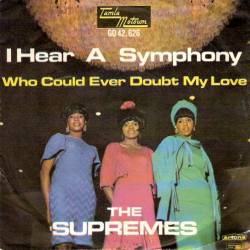- I Hear a Symphony
Single infobox |
Name = I Hear a Symphony

Artist =The Supremes
from Album = I Hear a Symphony
Released =October 6 ,1965
Format = 7" single
Recorded =Hitsville USA (Studio A);September 22 ,September 28 ,September 29 , andSeptember 30 ,1965
Genre = Soul/pop
Length = 2:40
Label =Motown
M 1083
Writer =Holland-Dozier-Holland
Producer =Brian Holland
Lamont Dozier
Chart position =
*# 1 (US Pop Singles)
*# 39 (UK Singles Chart )
Reviews =
Last single = "Nothing But Heartaches "
(1965)
This single = "I Hear a Symphony"
(1965)
Next single = "My World Is Empty Without You "
(1965)"I Hear a Symphony" is a
1965 hit song recorded byThe Supremes for theMotown label. Written and produced by Motown's main production teamHolland-Dozier-Holland , "I Hear a Symphony" was the number one song on theBillboard Hot 100 singles chart for two weeks, fromNovember 14 ,1965 toNovember 27 ,1965 , and reached number two on the soul chart. In theUnited Kingdom , "I Hear a Symphony" made it to number fifty, and then dropped off the charts for two weeks before re-entering at number thirty-nine.History
The Supremes enjoyed a successful run of hits in 1964 - 1965, and their producers
Holland-Dozier-Holland did their best to keep turning the hits out. In mid-1965, the producers came to realize they had fallen into a rut when the Supremes' "Nothing But Heartaches" failed to make it to the Top Ten, missing it by just one position and breaking the string of number-one Supremes hits initiated with "Where Did Our Love Go ." Motown chiefBerry Gordy was displeased with the performance of "Nothing But Heartaches," and circulated a memo around the Motown offices that read as follows::"We will release nothing less than Top Ten product on any artist; and because the Supremes' world-wide acceptance is greater than the other artists, on them we will only release number-one records."
Holland-Dozier-Holland therefore set about breaking their formula and trying something new. The result was "I Hear a Symphony," a song with a more complex musical structure than previous Supremes releases. "Symphony" was released as a single in place of another Holland-Dozier-Holland Supremes song, "Mother Dear", which had been recorded in the same style as their earlier hits.
"I Hear a Symphony", later issued on an album of the same name, became the Supremes' sixth number-one hit in the United States. After the number-five hit "
My World Is Empty Without You " and the number-nine hit "Love is Like an Itching in My Heart," the Supremes began a run of four more number-one hits: "You Can't Hurry Love ," "You Keep Me Hangin' On ," "Love Is Here and Now You're Gone ," and "The Happening ."Credits
* Lead vocals by
Diana Ross
* Background vocals byFlorence Ballard andMary Wilson
* Instrumentation by TheFunk Brothers ample
ee also
*
Hot 100 No. 1 Hits of 1965 (USA)
Wikimedia Foundation. 2010.
